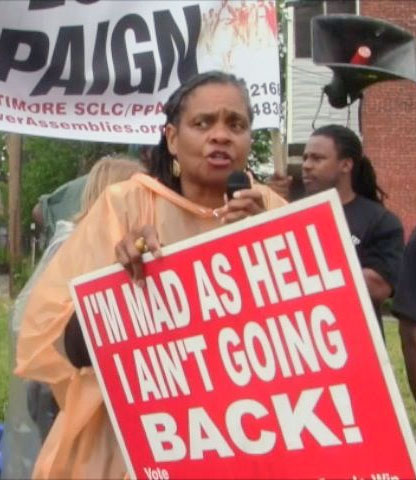

Civil Rights veteran Rose Sanders.
A handful of marchers who had elected to walk through the night joined the larger group to applause for their high spirits. Everyone marched the last 10-mile segment of the 41-mile trek from Baltimore to Washington, D.C.
At the Justice Department, demonstrators defied police to express their outrage at two critical issues: police terror and defending voting rights. Jeralynn Blueford, mother of murdered Alan Blueford, gave an impassioned plea to lock up killer police. Dr. Charles Steele, national CEO of SCLC Southern Christian Leadership Conference, proclaimed that we have to return to the days of the Rev. Dr. Martin Luther King Jr. “We must be prepared to sit in, go to jail or even lay down our lives for the cause of freedom.”
At a rally at Freedom Plaza in the center of Washington, Bob Ross, president of the Prince Georges County NAACP and a major organizer of the two-day commemoration, spoke. Ross is currently leading major anti-police brutality struggles. Two veterans of the original 1968 Poor People’s March Luis Zapata and Carlos Duffley, who also represented a representative of the People’s Organization for Progress, gave greetings to the rally. Bianey Elias, of Good Jobs for D.C., spoke in Spanish about the rights of low-wage workers. Speakers included three representatives of Peace House.
President Bill Preston, of American Federation of Government Employees Local 17, gripped the audience as he expressed the solidarity of union workers — some of whom, he said, live in poverty despite holding jobs — with the poor people on the march. Joe Lombardo, a spokesperson for the United National Antiwar Coalition, addressed the crowd. Cultural artists Luci Murphy, Eric Sheptock and Pam Parker sang songs of struggle. The Rev. C. D. Witherspoon chaired, and Larry Holmes, a People’s Power Assembly Movement organizer, spoke, as did some of those who had marched the entire 41 miles.
What’s next
Following the rally, marchers convened a People’s Power Assembly to strategize future steps. Larry Hales, of the PPA movement, opened the session calling for a moment of silence in recognition of Malcolm X’s grandson, Malcolm Shabazz, who was murdered in Mexico after being under FBI surveillance for the last two years.
Rev. Witherspoon. co-chair of the session, discussed epidemic police terror throughout this country. He proposed a multiprong strategy, calling for a national tribunal where victims could directly tell their stories. This campaign includes a call for congressional hearings to demand indicting killer police and community control.
Sharon Black, co-chair of the session, summed up some of the other proposals. OUR Walmart workers had introduced a proposal the previous day in Baltimore for an occupation of Walmart headquarters on June 7 in Bentonville, Ark. This was a logical extension of the justice for low-wage workers campaign mandated by the Baltimore PPA on Dec. 15.
Black also called for holding PPAs across the country to realize the dream that Dr. King first proposed as part of the 1968 Poor People’s Campaign: to take the campaign from symbolism to direct action, to go to Washington and stay until justice is won. The body also discussed supporting actions to mark the 50-year anniversary on Aug. 28 of the 1963 Jobs and Freedom march.
March organizers planned to support actions by local activists fighting for a living wage bill in Washington, D.C., on May 13.
March greeted enthusiastically
Workers World newspaper, which published a special issue focused on the Poor People’s March, organized a distribution to people attending the weekend events. Responding positively to the newspaper as honestly telling their story, marchers helped distribute papers to others walking with them and to people on the streets watching their progress.
Participants noted that not only in the poor, mostly Black neighborhoods of Baltimore, but in working-class, mostly white, neighborhoods on the way to central Washington, people in their homes and on the sidewalks greeted the marchers enthusiastically, with clapping and cheering.
One person who witnessed the march wrote an email to PPM organizers on May 11: “I didn’t know this was happening and found out about the event this evening driving down Rt. 1 in Howard County where I saw the walkers. I wish I had known about this previously so that I could have provided more support. I was moved when I saw the walkers, honked my horn and gave them a thumbs-up. Wish I could have done more.”
At this time in the United States, a groundswell of solidarity with the poor could be seen on the route from Baltimore to Washington, D.C.
WW photos: Brenda Ryan
The following call, “Gaza cries out to you – A global solidarity week to support…
Ever since the Donald Trump/Elon Musk administration took the reins of power in late January,…
The following is a letter from Workers World Party to the Workers Party of Korea…
Statement of the anti-imperialist Citizens’ Pole organization in Panamá, issued April 10, 2025. Translation: John…
Philadelphia Philadelphia’s transit system, the Southeastern Pennsylvania Transit Authority (SEPTA), released a budget on April…
By Gary Wilson The following is a guest article published first on April 10, 2025…